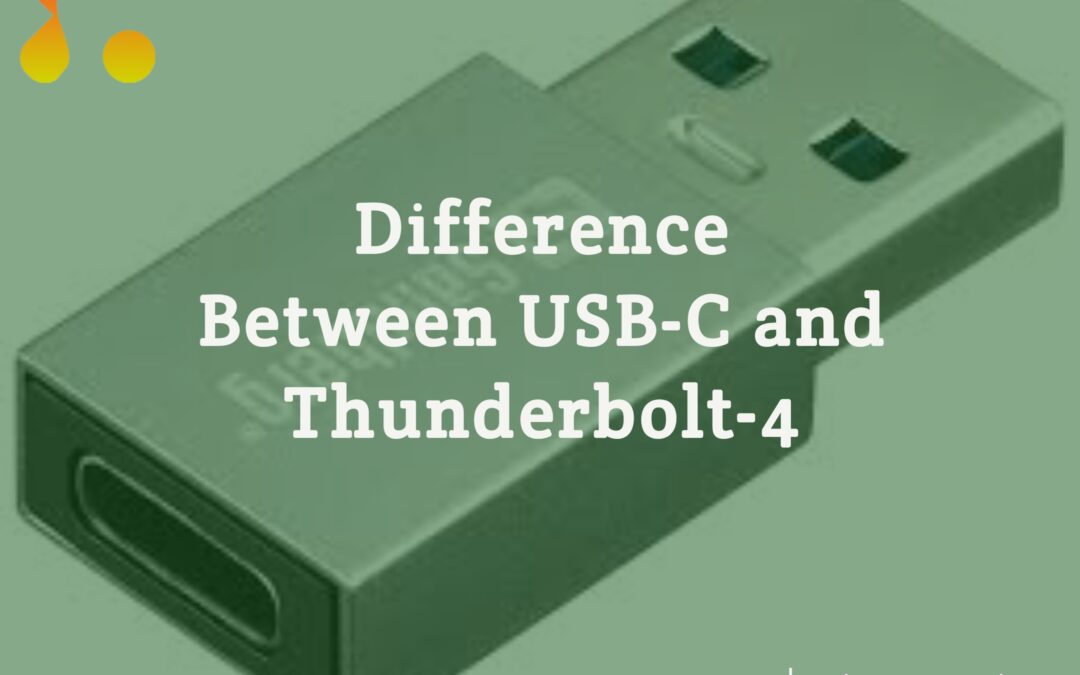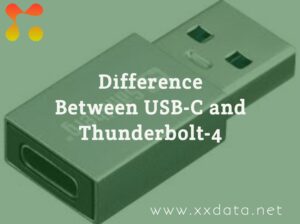The ports and connectors play a crucial role than most people realize from charging our smartphones to transferring large files or connecting external displays. The type of port on the device you’re using greatly determines its speed and efficiency.
Among the most popular port options, USB-C has become the universal standard for many modern gadgets, while Thunderbolt 4 is mostly seen in high-end laptops and advanced professional setups.
Although both ports look nearly identical from the outside, they are not the same in their performance or capability. Many users get confused when choosing between them, especially when buying new devices. This article will break down the differences between USB-C and Thunderbolt 4, explaining how each of them works, and help you in deciding which one best suits your needs.
What is USB-C?
USB-C (popularly known as type c) is a modern connector type that has quickly become the standard for smartphones, tablets, laptops, and accessories. Unlike older USB versions with larger and one-sided plugs, USB-C has a small, reversible design, which means you can plug it in either way without worrying about the orientation.
USB-C is widely loved because of its versatility. A single port can handle fast charging, data transfer, and even video output. Interestingly, many Android devices, MacBooks, and Windows laptops now rely on USB-C for everyday use. Depending on the version (USB 3.2, USB 4, etc.), it can transfer data at speeds ranging from a few gigabits per second up to 40Gbps.
Its biggest advantage is universality; most modern gadgets use USB-C, making it easier for users to carry fewer cables. However, not all USB-C ports offer the same speed or features, which is where confusion often begins.
What is Thunderbolt 4?
Unlike USB-C, Thunderbolt 4 is an advanced connection standard developed by Intel which uses the same small, reversible connector. At first glance, it looks identical to USB-C, however, the difference lies in its capabilities and performance. Thunderbolt 4 is essentially a supercharged version of USB-C, offering faster speeds, higher bandwidth, and more reliable performance.
Interestingly, if you own a Thunderbolt 4, you get data transfer rates up to 40Gbps, support for dual 4K displays or a single 8K monitor, and the ability to connect multiple devices through daisy-chaining. It also provides stronger charging capabilities and supports external GPUs, making it a top choice for professionals who need heavy computing power.
Unlike standard USB-C, Thunderbolt 4 is usually found on premium laptops, desktops, and docking stations, especially those designed for creative work or gaming. This makes it less common than USB-C, but much more powerful in demanding tasks.
Read Also: Best Prepaid Plan for International Travel in 2025
USB-C Vs Thunderbolt 4
Although USB-C and Thunderbolt 4 share the same connector design, their performance and features are very different. Below are the main differences you need to know;
Speed and Data Transfer Rates
In terms of speed and transfer rates, USB-C supports a wide range of speeds depending on its version. For example, USB 3.2 can reach up to 20Gbps, while USB4 supports up to 40Gbps. On the other hand, Thunderbolt 4 guarantees 40Gbps across all devices, making it more reliable for tasks like moving large files, editing 4K/8K videos, or gaming with external drives.
Video Output Capabilities
In the case of video output capabilities, USB-C can handle video output, but the quality depends on the version and device. Some USB-C ports only support a single display or lower resolutions. In contrast, Thunderbolt 4 can support two 4K displays at once or a single 8K display, providing a massive advantage for professionals who need multiple high-resolution screens.
Power Delivery and Charging
For power delivery and charging, both USB-C and Thunderbolt 4 support USB Power Delivery (USB-PD), which allows fast charging. However, Thunderbolt 4 ensures consistent 100W charging for laptops and other devices, while standard USB-C charging can vary depending on the manufacturer and cable. This makes Thunderbolt 4 more reliable for powering demanding devices.
Device Compatibility
USB-C is extremely universal. It works across Android phones, tablets, headphones, laptops, and accessories. Thunderbolt 4, while backward compatible with USB-C, is found mainly on Intel-based premium laptops, Macs, and docking stations. Not every device supports it, which makes USB-C more common in everyday use.
Use Cases (Everyday vs. Professional Use)
USB-C is perfect for everyday users who need basic charging, data transfer, and single display connectivity. It’s affordable and widely available.
Whereas Thunderbolt 4 is designed for professionals handling video editing, 3D rendering, gaming setups, or advanced workstations where speed and multiple connections matter.
Read Also: Best Battery Saving Tips for Android
Which One Should You Choose: USB-C or Thunderbolt 4?
The choice between USB-C and Thunderbolt 4 depends on your needs. For most people, USB-C is more than enough. It handles fast charging, file transfers, and even connects to external displays all at an affordable cost and with wider availability across smartphones, tablets, and laptops.
However, if you’re a professional working with video editing, graphic design, or gaming setups, Thunderbolt 4 is the better option. Its guaranteed high speed, multiple monitor support, and reliability with external devices make it worth the investment, even if it’s mostly found on high-end laptops and docking stations.
Final Thought
At first glance, USB-C and Thunderbolt 4 may look identical, but their capabilities set them apart. USB-C has become the universal standard, making it the go-to option for charging, data transfer, and connecting everyday devices. On the other hand, Thunderbolt 4 takes performance to another level with lightning-fast data speeds, support for multiple high-resolution displays, and reliable power delivery.
if you’re an the average user, USB-C is more than sufficient, offering versatility and convenience at a lower cost. But for professionals who demand speed, multitasking, and advanced connectivity, Thunderbolt 4 is the preferred choice. Understanding these differences helps you make smarter choices when buying your next device or accessory.


